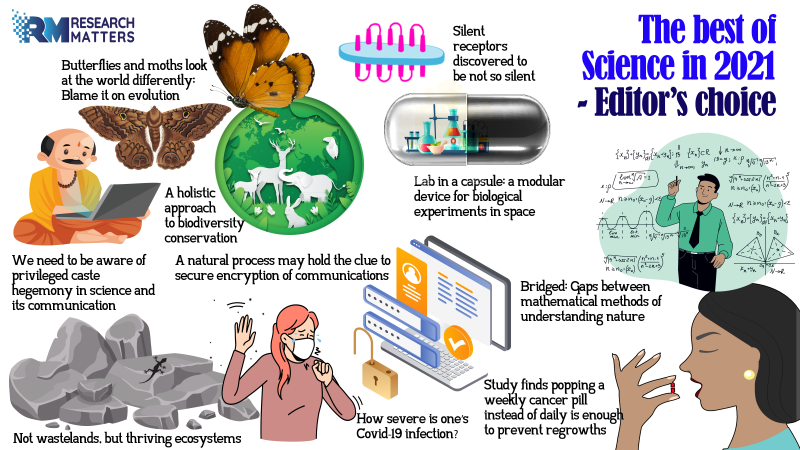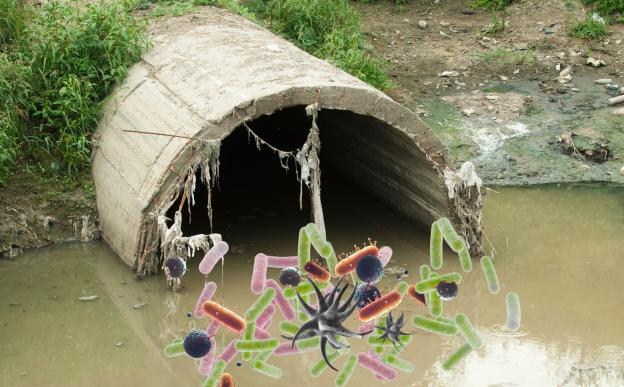
In 2021, the pandemic continued in new avatars, throwing different challenges at us. Undaunted, researchers dived into the far realms of science, and we at Research Matters strived to bring those fascinating finds to the fore.
As we step into 2022, it is time we reflect on the stories we published in the past year. It was tough to say 'the best among them are…', for each had an impact of their own. However, the editorial team at Research Matters has carefully curated ten exciting stories (in no particular order of preference) that stood out – worth going through (perhaps again). Our choice ranges from our continued understanding of the ecosystem to building a lab-on-a-chip that finds use for biological experiments in space. We are sure you will find them absorbing.
Nature rules
Among our core interests are research in ecology, conservation, climate change, and all things related to nature. So evidently, these stories grabbed our attention first. Read on to know more.
If you think humans have superior vision, think again. The elusive and dainty moths and butterflies may not have well-developed eyesight like ours; however, their ability to sense the environment is far superior to ours. Scientists use a parameter called 'flicker fusion frequency, FFF, to measure the rapidity of response. Butterflies and moths look at the world differently: Blame it on evolution is a story about a fun activity that turned into a research study. Researchers from NCBS and TIFR, Bengaluru, and IISER, Pune, analysed the FFF variations in moths and butterflies to determine their day and night time sensing abilities.
Not wastelands, but thriving ecosystems alerts us to our skewed perception of waste and barren landscapes. Contrary to our belief, they are teeming with endemic species of flora and fauna, which are direly in need of protection, say researchers from ATREE, Bengaluru. Moreover, the researchers point out that sadly, these landscapes are targets for renewable-energy farms and eco-measures, further jeopardising the situation. This must-read interview showcases how the researchers mapped these landscapes of India to be available to all for scrutiny.
Having said that, it brings us to A holistic approach to biodiversity conservation. A study by another research team from ATREE shows that the current policies of protected areas, boundaries of forests and human dwellings are not factoring in the livelihood of tribal communities who survive in and on forests. Read this engaging account of how the research team and a few local bodies set an example of inclusivity and coexistence.
Math to the rescue
In Bridged: Gaps between mathematical methods of understanding nature, we get a glimpse into the history and nuances of how some mathematical approaches helped understand our world over the decades. The advent of computers and algorithms boosted it. Read this story about how an IISc team utilised a missing facet of an earlier mathematical approach. Their modified version can enhance our understanding of particle physics greatly.
Computer scientists employ numerical methods to generate random numbers to secure data encryption. However, the sequences are not entirely 'secure'. Who knew, principles of Brownian motion – a natural phenomenon of the random motion of solid particles suspended in a fluid – could give ideas to generate secure sequences of random numbers! A natural process may hold the clue to secure encryption of communications delves into this intriguing experiment carried out by researchers from IISER-Kolkata.
Breakthroughs in biology
We are on the brink of another COVID-19 wave. While RT-PCR testing can tell us if we have the infection, unfortunately, it cannot tell us how severe the condition is. We found How severe is one's Covid-19 infection? a relevant re-read at this juncture. The researchers from IIT Bombay and Kasturba Hospital for Infectious Diseases found that the presence of specific viral or host proteins in the swab samples could indicate the disease severity. Definitely, a valuable resource for effective distribution of healthcare services. Read on to know more.
While the world was occupied with the pandemic, a research team from ACTREC, Mumbai, made headway in cancer treatment. Their study (now undergoing clinical trials) revealed that daily medications may not be necessary to keep lung cancer regrowths at bay. Instead, they show that a weekly dose of the pill would suffice. Read Study finds popping a weekly cancer pill instead of daily is enough to prevent regrowths to know more about the experiment details.
Receptor molecules on cells respond to external environmental triggers in myriad ways. We are still deciphering the mysteries of these molecular mechanisms, which hold the key to developing advanced drugs for many diseases. Silent receptors discovered to be not so silent is an account of one such exciting research. In a collaborative study, scientists from IIT Kanpur, Tohoku University, Japan, McGill University, Canada, and Queensland University, Australia, found that a known receptor was using an unconventional and, in fact, a pathway that arrests protein response for signalling. Now, would this discovery rewrite textbooks? Read on to know more.
We are making strides in space ventures and poised to build habitats on the moon. For this, scientists propose to utilise a bacterial process called microbially induced calcite precipitation to convert lunar soil to construction material. For this, bacterial experiments must be conducted in space. Since sending bulky lab equipment to space is a costly affair, researchers from IISc, Bengaluru, collaborated with ISRO scientists and shrunk the equipment! Lab in a capsule: a modular device for biological experiments in space showcases this fascinating research.
And, lastly, as each one of us is the primary stakeholder of investment in science, effective and wide communication of science is of paramount importance. The writer of We need to be aware of privileged caste hegemony in science and its communication sees India's science communication roadmap through a different lens. Picking on an event, this opinion piece raises some pertinent questions that warrant a deeper reflection on how we communicate science. The story throws light on the language diversity in India noting the lack of science communicators in regional languages. The article stresses the need for communicating science in regional languages without propagating inherent biases that would otherwise confine the communication to a limited audience.
As we round up the year's activities, we are excited about the year ahead and another incredible journey with you. So stay tuned for satiating your scientific temper as we bring you many more exciting science stories wrapped in lucid narratives.
Do stay connected with us as always on our social media platforms.
Research Matters wishes you a healthy, safe, and spectacular year ahead!
























